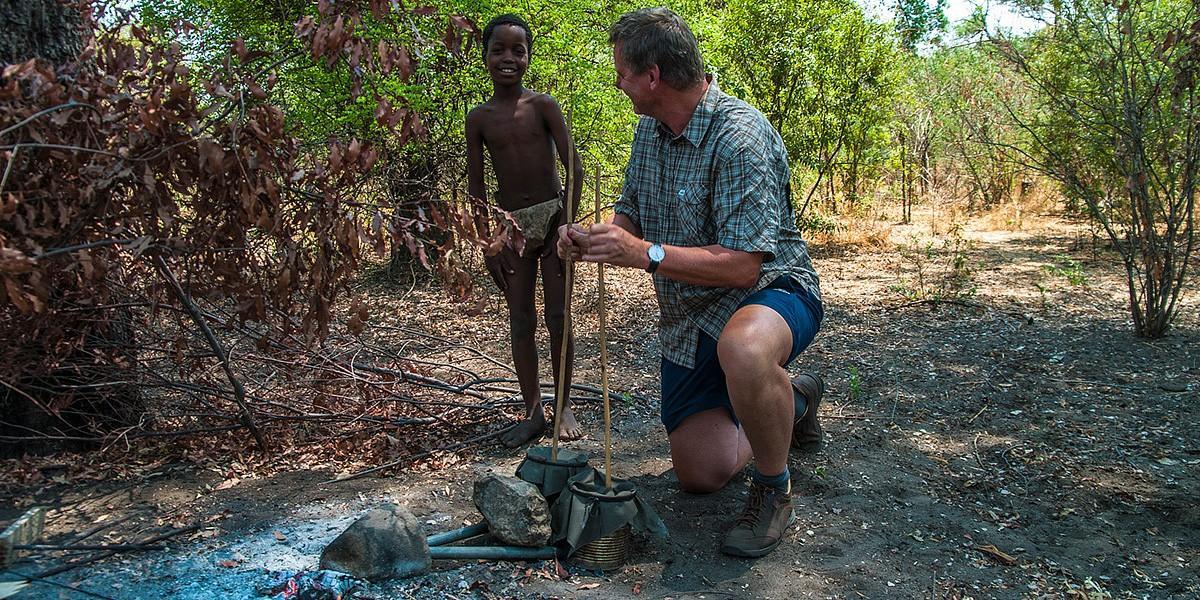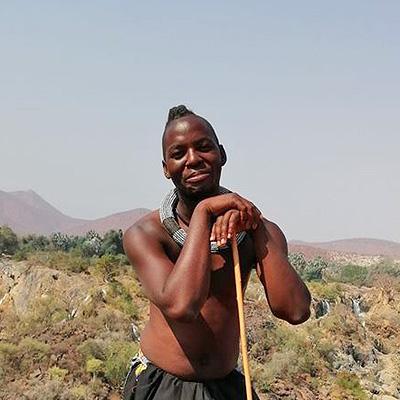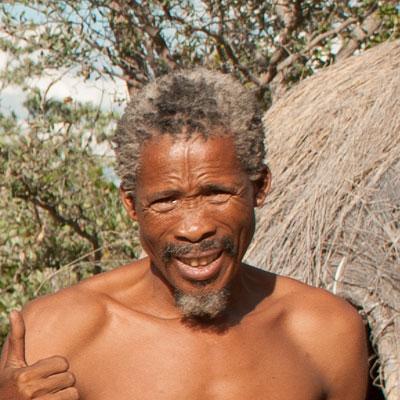Fascinating culture of the San
Project report by Dr. Ralf Kühn
Read a project report from the LCFN project tour 2020 by Ralf Kühn and Sebastian Dürrschmidt with the visit of four projects.
Dear friends and members of LCFN,
I have just returned from Namibia with a lot of impressions. The corona pandemic also led to a very strict lockdown in Namibia, which not only affected the social life of the Namibians, but also set the main economic sector - tourism - to "zero". There were hardly any international tourists in the country for 6 months and all borders were closed. State aid for businesses in tourism doesn't exist in Namibia. Hence Sebastian, Claudia and I, the board of directors of the Living Culture Foundation Namibia, thought about how we could save the Living Museums which had no more income. The idea of an appeal arose and so in spring and summer we started a successful fundraising campaign through “Betterplace” to preserve the museum landscape for lively old Namibian culture supported by the LCFN. Together with direct donations, an amount of approx. 12,000 euros could be collected.
Claudia and Sebastian had already distributed the donations which included food and blankets to the museums over the past few months. This at least compensated for the supply of food in the absence of day-to-day business.
As Namibia is currently one of the few travel destinations in the world with a very low risk of COVID-19 infection, and hence no quarantine requirement for travelers after the trip, tourism and with it the situation in museums is slowly starting to pick up a little.
Sebastian and I, accompanied by Günter and Moritz from Dortmund (also future members of the LCFN), drove north to discuss the current situation with the managers, but also to tackle new projects at the individual locations.
Ju/'Hoansi Living Museum visit
In Grashoek we visited the Ju / `Hoansi, the oldest Living Museum of our association, which opened in 2004 and has been cooperating with the LCFN since 2007. The signboards to the museum and the information boards at the entrance of the museum have to be renewed or redesigned. The program is very nice with thr bush walk, the joint making of a bow at eye level, the sporty part with shooting at the straw antelope and the small cultural program with singing and traditional games.

Mbunza Living Museum and project meeting
We were warmly welcomed by Sebron at the Mbunza at the Okavango River. He informed us that there had been almost no visitors to the museum since the beginning of the infection wave. In order to increase the number of visitors in the medium term, the construction of a campsite in the immediate vicinity of the museum is planned. A cost estimate was presented to us for water, sewage and electricity supply. After a little post-processing, we agreed on financial support from our association. This is to be realized again through a direct donation project on "Betterplace".
The visitor-free time in the Mbunza Museum is also used to repair the infrastructure in the museum village. Fences have to be repaired, roofs sealed, and new inventory and furnishings have to be purchased. We have made a donation for this because - in contrast to all other museums - traditional materials can no longer be harvested by the Mbunza. The area where the Mbunza can harvest their wood for repairs and new buildings is 40 km away. Here a transport company has to be commissioned to transport the wood, the costs of which will be covered by the foundations funds.
Investment is also needed for new display boards and signs. After the detailed program (we also returned a small thank you program with German songs), we had time to talk to Sebron about the next goals. Sebastian is planning a meeting of all museum managers in Windhoek at the beginning of 2021 in order to promote intercultural cooperation among the different museums and to discuss a number of issues relating to various items on the program (e.g. "Professional filming in the museum") There is also need for clarification regarding the guiding, which we want to improve by means of a workshop.

Visit Mafwe Museum
We visited the Mafwe Museum in the Zambezi region. There was a reunion with Mrs. Elizabeth Madima and her son Gifty, who were in Tangermünde for the “International Museum Day” in 2017. In the meantime, a new museum village has emerged not far from the Zambian border. In traditional clothing and with a lot of singing we were led on an extensive tour through the different stations of the museum guided by Gifty. It's a nice feeling to sense the trust people have in the museums, but also their pride for their culture, for what they have created themselves and for the knowledge they can pass on in the museum.

New project: Khwe Living Museum
Finally, Sebastian and I spent some time at a new project. Near Divundu, not far from the Okavango is the home of the Khwe Bushmen. Originally native to the Okavango area, their native language with click sounds belongs to the Khoisan language family.
In several meetings with the manager Tadeus, Sebastian had already discussed the structures and processes expected in a museum supported by the LCFN. After a hesitant start, the ice now seems to have broken. Using role-play we again explained the tasks of the guide of a Living Museum. My task as an interested museum visitor, however, was easier. I was allowed to ask a lot of questions, it was certainly the beginning of a new - the 7th - museum of the LCFN.

We noticed that it is not easy for really interested museum visitors to understand, assign and retain the knowledge that is conveyed. In addition to the language of the guides (African English with culture-specific subtitles), this is also due to the guiding itself, the ability to convey the complexity of the cultures, etc.
In order to provide museum visitors with further information, we had the idea of creating a small museum guide for our LCFN educational institutions, with a representation of each museum, a small "virtual" tour through the traditional villages and information on origin, language, a small dictionary (only the 20 most important expressions), social structure, dissemination of culture etc. etc. That should increase the demands on a museum and deepen the information and knowledge about our work. This information can also be conveyed with display boards at the reception. The museum guide is to be sold by the museums, the proceeds are to be used exclusively for the so-called "maintenance pot" of the living museums, ie for repairs, new acquisitions, materials, etc. and thus also serve to continuously improve the museum.
The museum guide is to be financed by our association, here we are looking for donors who are well represented on the last page of the guide. So if you have the right contacts, we are grateful for donations of € 1000 or more. We expect production costs of around € 6000 for the first edition.
There is still a lot to be done to ensure that, in addition to creating jobs in the cultural sector, we fulfill the aspiration of being a sound educational establishment. But I think we are on the right track!
Warm greetings,
Ralf Kühn
When you subscribe to the blog, we will send you an e-mail when there are new updates on the site so you wouldn't miss them.


























